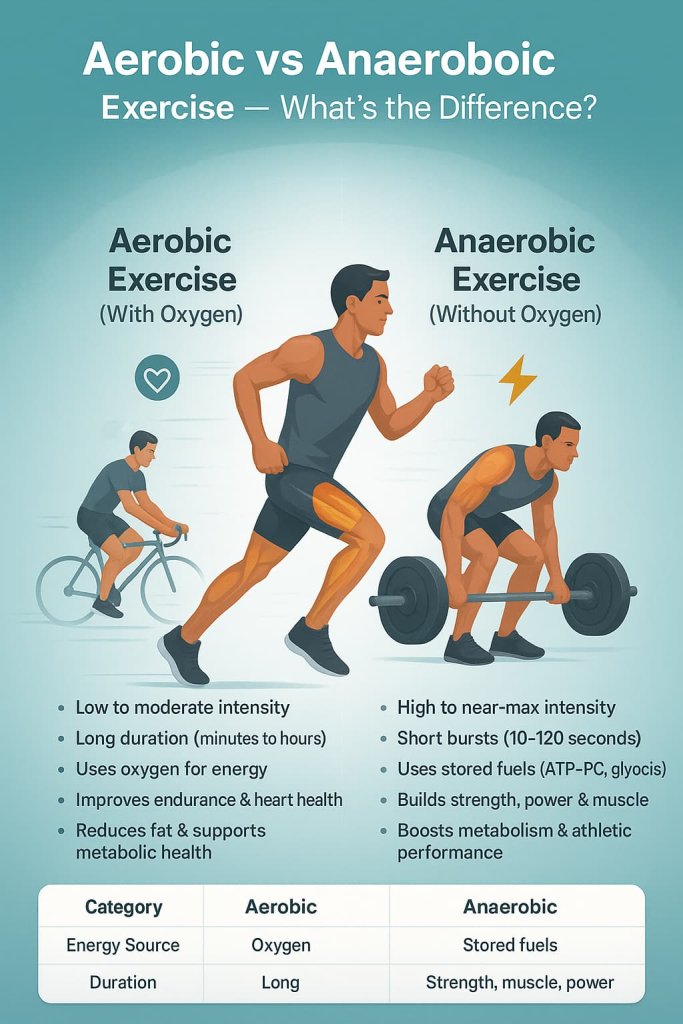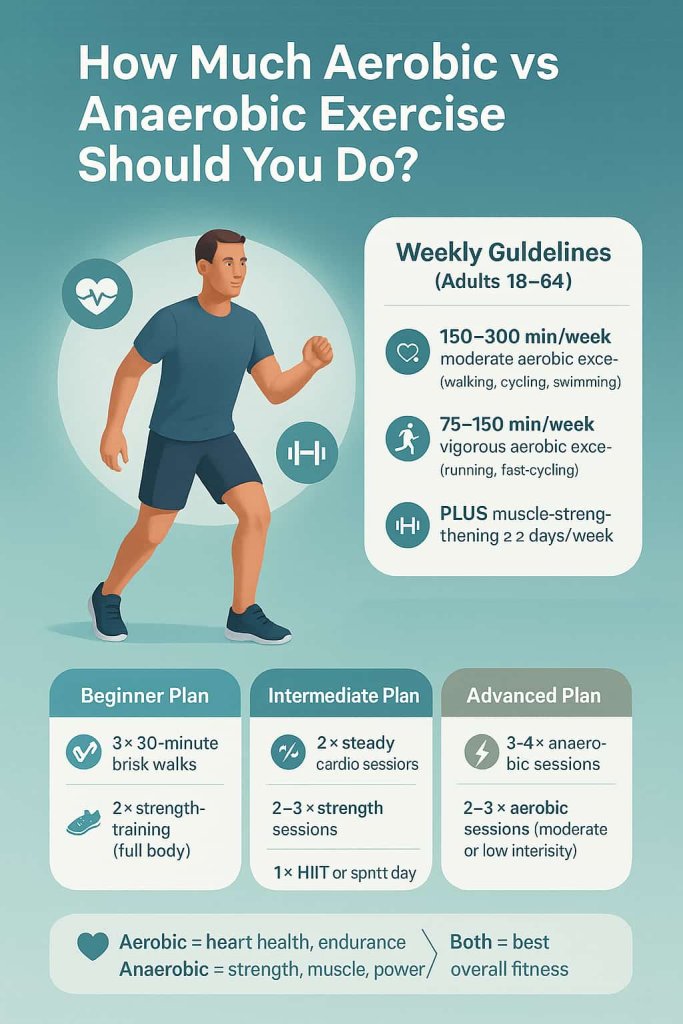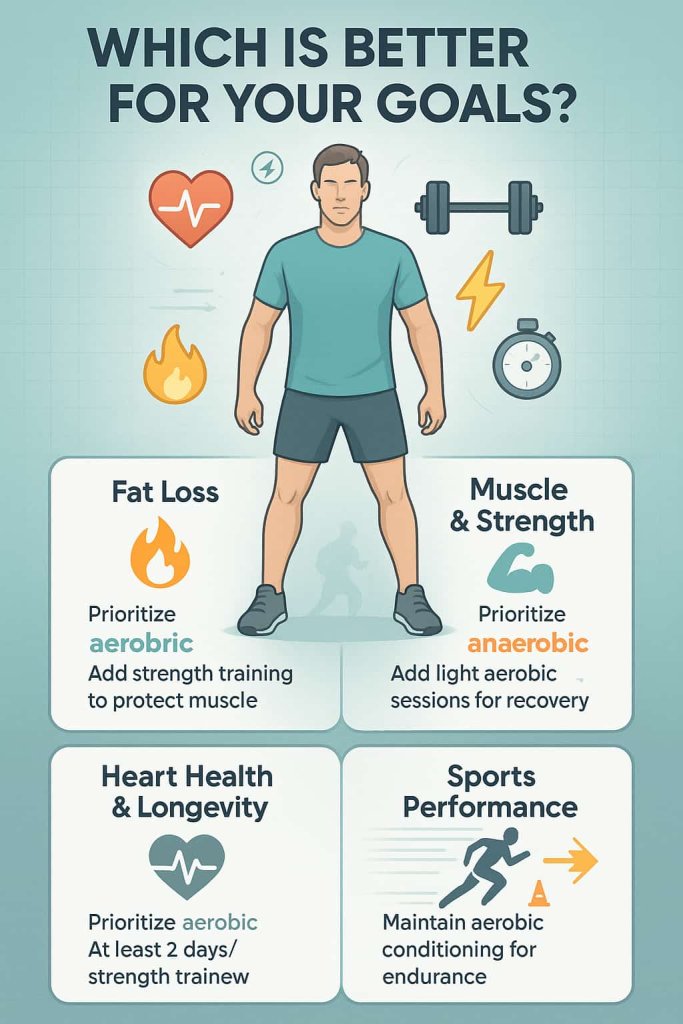The main difference between aerobic and anaerobic exercise is that aerobic workouts use oxygen for sustained energy, while anaerobic workouts rely on stored fuels for short, high-intensity bursts.

Understanding this difference is crucial because each training type affects your heart, muscles, metabolism, and fat loss results differently. Aerobic exercise supports endurance and heart health, while anaerobic exercise builds strength, power, and muscle. Most people benefit from a balanced mix of both.
This guide breaks down definitions, differences, benefits, examples, recommended weekly targets, and a practical plan so you can safely choose the best workout style for your goals.
What Is Aerobic Exercise?
Aerobic exercise means “with oxygen.” Your body relies on oxygen to generate energy over long periods.

Common Aerobic Examples
- Brisk walking
- Jogging or steady running
- Swimming
- Cycling
- Rowing
- Hiking or dancing
- Elliptical, stair stepper, or low-impact aerobics
How Aerobic Training Works
Aerobic exercise uses the oxidative energy system, allowing you to sustain activity from several minutes to hours. This improves cardiovascular endurance and overall metabolic health.
What Is Anaerobic Exercise?
Anaerobic exercise means “without oxygen.” Your body relies on stored energy (ATP-PC and anaerobic glycolysis) for short, intense efforts.

Common Anaerobic Examples
- Sprints (20–60 meters)
- Hill sprints or cycling sprints
- HIIT intervals
- Heavy weightlifting (low reps)
- Plyometrics (jump squats, box jumps)
- Explosive sports drills
- Battle ropes or medicine-ball slams
How Anaerobic Training Works
Anaerobic exercise produces high power output but only for short periods (10–120 seconds). It builds strength, speed, and fast-twitch muscle fibers.
Aerobic vs Anaerobic: Key Differences
| Category | Aerobic Exercise | Anaerobic Exercise |
|---|---|---|
| Energy Source | Uses oxygen | Uses stored fuels (ATP-PC, glycolysis) |
| Duration | Long (minutes to hours) | Short (10–120 seconds) |
| Intensity | Low to moderate | High to near-max |
| Primary Benefits | Heart health, endurance, fat loss | Strength, muscle, power |
| Best For | Longevity, cardiovascular function | Athletic performance, body composition |
| Examples | Walking, cycling, jogging | HIIT, sprints, strength training |
Benefits of Aerobic Exercise
Aerobic training is strongly supported by WHO, CDC, and AHA for long-term health.

Major Benefits
- Improves heart and lung function
- Reduces risk of chronic diseases (heart disease, stroke, type 2 diabetes)
- Supports mental well-being and reduces anxiety
- Boosts endurance and stamina
- Aids fat loss and reduces visceral fat
- Supports healthy blood pressure and cholesterol levels
Research Insight
A 2024 JAMA Network Open review found a linear dose-response—more aerobic minutes = greater reductions in body fat and waist size.
Authoritative resources:
- WHO Physical Activity Guidelines
- CDC Cardio Health Resources
- Harvard Health Exercise Recommendations
Benefits of Anaerobic Exercise
Anaerobic training is essential for strength, muscle, and performance.

Major Benefits
- Builds lean muscle mass
- Increases strength, power, and speed
- Boosts resting metabolism
- Supports bone density and joint stability
- Improves athletic performance and fast-twitch activation
- Enhances insulin sensitivity and metabolic health
Research Insight
Comparative studies show:
- Anaerobic training → greater strength & muscle gains
- Aerobic training → greater fat reduction
- Combination → best body composition improvements
Which Is Better for Fat Loss?
Short Answer:
- Aerobic = superior for calorie burning and fat loss
- Anaerobic = superior for maintaining muscle (helps long-term fat loss)
- Best results = a combination of both
Large-scale reviews show aerobic training is highly effective for fat and waist reduction, while resistance training ensures you keep or gain lean muscle.
How Much Aerobic vs Anaerobic Exercise Should You Do?

Adults (18–64)
According to WHO (2020) and CDC (2023):
- 150–300 min/week of moderate aerobic exercise, OR
- 75–150 min/week of vigorous aerobic exercise
- PLUS muscle-strengthening (anaerobic) activities ≥ 2 days/week
Simple Weekly Mix
Beginner:
- 3 × 30-minute brisk walks
- 2 × strength-training sessions (full body)
Intermediate:
- 2 × steady cardio sessions
- 2–3 × strength sessions
- 1 × HIIT or sprint day
Advanced:
- 3–4 × anaerobic (strength + HIIT)
- 2–3 × aerobic (moderate or low intensity)
Who Should Focus More on Aerobic vs Anaerobic Exercise?
Most people benefit from including both training styles, but your priority should match your health status, fitness level, and goals. Here’s a short, clear guide to help you decide where to put your focus.
You Should Focus More on Aerobic Exercise If You:
- Are new to exercise and need a safe, gradual starting point
- Have high blood pressure, heart disease, diabetes, or metabolic concerns (with medical clearance)
- Are an older adult who needs joint-friendly, steady movement for heart and brain health
- Prefer lower-impact activities such as walking, cycling, or swimming
- Want to improve endurance, reduce daily fatigue, or support long-term cardiovascular health
- Are aiming for steady fat loss and want an activity you can maintain consistently
You Should Focus More on Anaerobic Exercise If You:
- Want to build muscle, strength, or power
- Need to improve body composition and maintain or increase lean mass
- Play sports that rely on speed, agility, sprints, or explosive movements
- Prefer shorter, high-effort workouts such as strength training or HIIT
- Want to boost metabolism and improve functional strength for daily activities
When You Should Combine Both
A balanced mix is ideal if you want overall health, fat loss, better performance, and long-term fitness. Most adults achieve this by pairing 150 minutes/week of aerobic activity with at least two days/week of strength training, following WHO and CDC guidelines.
Which Is Better for Your Goals?

Fat Loss
- Prioritize aerobic
- Add strength training to protect muscle
Muscle & Strength
- Prioritize anaerobic
- Add light aerobic sessions for recovery
Heart Health & Longevity
- Prioritize aerobic
- Add strength at least 2 days/week
Sports Performance
- Prioritize anaerobic
- Maintain aerobic conditioning for endurance
Safety Tips Before You Begin
Follow these guidelines to train safely, especially for high-intensity work:
- Start gradually if you’re new or returning after a break
- Warm up your joints (ankles, hips, shoulders) before all workouts
- Use proper technique—avoid rushing or swinging weights
- Stop if you feel sharp pain, chest discomfort, or dizziness
- Increase intensity slowly over weeks
- If you have heart disease, diabetes, joint issues, or mobility limitations, consult a healthcare professional before starting vigorous anaerobic training
- Combine workouts with hydration, adequate recovery, and sleep
FAQs
1. Is anaerobic exercise better than aerobic for weight loss?
Anaerobic training builds muscle, but aerobic exercise burns more calories. The best approach is combining both.
2. Can beginners do anaerobic exercise?
Yes, but start with light strength training and avoid maximal sprints or heavy plyometrics until your fitness improves.
3. How often should I do HIIT?
Most guidelines recommend 1–2 HIIT sessions per week due to high intensity and recovery needs.
4. Does aerobic exercise burn muscle?
Not when balanced with strength training and proper nutrition.
5. Which is better for heart health?
Aerobic exercise has the strongest evidence for cardiovascular benefits.
6. Can older adults do anaerobic workouts?
Yes, but intensity should be adjusted, and strength training should be supervised if mobility or joint issues exist.
7. Is walking aerobic or anaerobic?
Walking is aerobic unless performed uphill or very fast at near-max effort.
Conclusion
Both aerobic and anaerobic exercise play essential roles in fitness and long-term health. Aerobic workouts support heart health, endurance, and fat loss, while anaerobic training builds strength, muscle, and power. The most effective approach is a balanced weekly routine that includes both training styles, adjusted to your goals and fitness level.
Ready to improve your health? Start with 150 minutes of aerobic movement each week and add at least two strength sessions.
